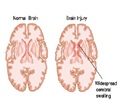A new study reveals that one in three patients whose life support was withdrawn due to a major bleeding in the brain could have eventually regained an acceptable level of functioning.

The new study, initially encompassing 590 patients at a Seattle hospital, was designed to see whether "self-fulfilling prognostic pessimism," might play a part in life-support decisions, said David Tirschwell, M.D., M.Sc., lead author and co-director of the University of Washington Stroke Center at Harborview, in Seattle. Researchers identified 78 patients whose life support was withdrawn and compared their outcomes with 78 similar patients who were not removed from life support. Researchers chose a disability rating of "moderately severe" or better as an "acceptable outcome."
Moderately severe could mean patients are unable to attend to their own bodily needs or be unable to walk without assistance, Tirschwell said. He also acknowledged that "acceptable outcome" is up to each individual’s perception and preferences. At hospital discharge, only 4 percent of matched patients whose life support was withdrawn had an acceptable outcome, compared with 38 percent of the matches who did not have life support withdrawn — suggesting 34 percent of the group whose support was withdrawn might also have had an acceptable outcome if support had been sustained."Greater patience and less pessimism may be called for in making these life-and-death decisions," he said.
For their analysis, the researchers created a "propensity score" indicating the probability that a decision to withdraw life support would be made for a given ICH patient. The propensity score was based on a number of factors: age; functional status before the ICH; level of consciousness; how much bleeding occurred; pre-existing hypertension; diabetes; atrial fibrillation; first temperature measurement on the patient; and whether the patient was intubated for breathing support. The strongest predictors of life support withdrawal — and the factors most crucial in the patient matching — were measures of the hemorrhage’s severity, Tirschwell said.
"These results are yet another piece of evidence suggesting healthcare providers may be overly pessimistic in their assessments of these patients’ prognoses, leading families to choose withdrawal of life support before the patient has had a chance to recover from their stroke," Tirschwell said. Most decisions to withdraw life support are made by next of kin, in consultation with other relatives and with doctors, in the first few days of hospitalization after the ICH, he said. In that time frame, "it would be unrealistic to think the patient has had a chance to attain any measure of recovery," he said.While "moderately severe" disability represents far-from-ideal capabilities, "the time of hospital discharge is likely only a couple of weeks after the ICH and recovery is a months-long process, and some of these patients — many even — might recover further," he said.
Tirschwell said the conclusions are based on the assumption of further recovery, which is known to be a long process and notoriously difficult to predict and the fact that quality of life is subjective. The study, conducted in one hospital, might not reflect practices at other institutions, Tirschwell said."The study does a commendable job measuring the effect on patient outcome of the decision-making process, probably the single most difficult factor to model," said Steven Greenberg, M.D., Ph.D., chair of the International Stroke Conference, Harvard Medical School neurology professor and director Hemorrhagic Stroke Research at Massachusetts General Hospital in Boston."
Advertisement
Advertisement














